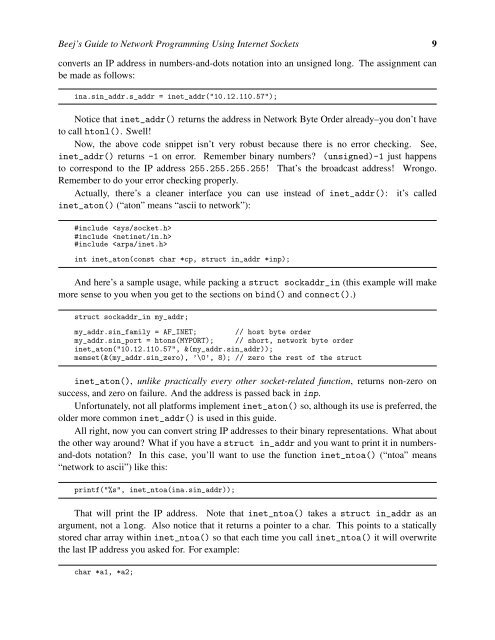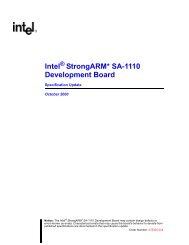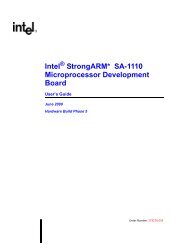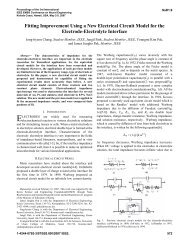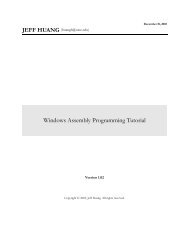Beej's Guide to Network Programming Using Internet Sockets
Beej's Guide to Network Programming Using Internet Sockets
Beej's Guide to Network Programming Using Internet Sockets
- No tags were found...
Create successful ePaper yourself
Turn your PDF publications into a flip-book with our unique Google optimized e-Paper software.
Beej’s <strong>Guide</strong> <strong>to</strong> <strong>Network</strong> <strong>Programming</strong> <strong>Using</strong> <strong>Internet</strong> <strong>Sockets</strong> 9converts an IP address in numbers-and-dots notation in<strong>to</strong> an unsigned long. The assignment canbe made as follows:ina.sin_addr.s_addr = inet_addr("10.12.110.57");Notice that inet_addr() returns the address in <strong>Network</strong> Byte Order already–you don’t have<strong>to</strong> call h<strong>to</strong>nl(). Swell!Now, the above code snippet isn’t very robust because there is no error checking. See,inet_addr() returns -1 on error. Remember binary numbers? (unsigned)-1 just happens<strong>to</strong> correspond <strong>to</strong> the IP address 255.255.255.255! That’s the broadcast address! Wrongo.Remember <strong>to</strong> do your error checking properly.Actually, there’s a cleaner interface you can use instead of inet_addr(): it’s calledinet_a<strong>to</strong>n() (“a<strong>to</strong>n” means “ascii <strong>to</strong> network”):#include #include #include int inet_a<strong>to</strong>n(const char *cp, struct in_addr *inp);And here’s a sample usage, while packing a struct sockaddr_in (this example will makemore sense <strong>to</strong> you when you get <strong>to</strong> the sections on bind() and connect().)struct sockaddr_in my_addr;my_addr.sin_family = AF_INET; // host byte ordermy_addr.sin_port = h<strong>to</strong>ns(MYPORT); // short, network byte orderinet_a<strong>to</strong>n("10.12.110.57", &(my_addr.sin_addr));memset(&(my_addr.sin_zero), ’\0’, 8); // zero the rest of the structinet_a<strong>to</strong>n(), unlike practically every other socket-related function, returns non-zero onsuccess, and zero on failure. And the address is passed back in inp.Unfortunately, not all platforms implement inet_a<strong>to</strong>n() so, although its use is preferred, theolder more common inet_addr() is used in this guide.All right, now you can convert string IP addresses <strong>to</strong> their binary representations. What aboutthe other way around? What if you have a struct in_addr and you want <strong>to</strong> print it in numbersand-dotsnotation? In this case, you’ll want <strong>to</strong> use the function inet_n<strong>to</strong>a() (“n<strong>to</strong>a” means“network <strong>to</strong> ascii”) like this:printf("%s", inet_n<strong>to</strong>a(ina.sin_addr));That will print the IP address. Note that inet_n<strong>to</strong>a() takes a struct in_addr as anargument, not a long. Also notice that it returns a pointer <strong>to</strong> a char. This points <strong>to</strong> a staticallys<strong>to</strong>red char array within inet_n<strong>to</strong>a() so that each time you call inet_n<strong>to</strong>a() it will overwritethe last IP address you asked for. For example:char *a1, *a2;


